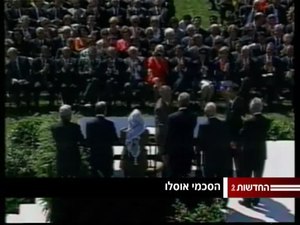Oslo peace process
The term Oslo Peace Process refers to a series of agreements between Palestinians and Israel that began in 1993 to resolve the Middle East conflict . The peace process got this name because the first secret negotiations between the disputing parties PLO and Israel took place in Oslo with Norwegian mediation .
Oslo I
On September 13, 1993, Foreign Ministers Mahmud Abbas , Shimon Peres , Warren Christopher and Andrei Kosyrew signed the " Declaration of Principles on Temporary Self-Government " (also known as Oslo I ) in the presence of Yitzhak Rabin , Yasser Arafat and Bill Clinton . This represents a milestone in the peace process. Both sides officially recognized each other for the first time. The Israelis accepted the PLO as the official representative of the Palestinians , and the PLO undertook to delete all passages from its charter that contained the goal of destroying Israel.
The agreement also contained a general agreement to transfer responsibility in the Gaza Strip and the West Bank to the Palestinians and to give them autonomous management of their affairs. Controversial issues such as the status of Jerusalem , the refugee issue or the settlements in the West Bank have not yet been dealt with in the agreement. Details should be determined in further negotiations.
The agreement was ratified by the Knesset a week later. A ratification by the PLO has not yet taken place.
- Paris Protocols
The Protocols on Economic Relations between Israel and the Palestinian Authority were signed in Paris on April 29, 1994. These protocols were even described by the later Israeli Foreign Minister Shlomo Ben Ami in his book A Place for All (1998) as "a cementing of colonial relations".
- Gaza-Jericho Agreement
With the Gaza-Jericho Agreement signed in Cairo on May 4, 1994 , the Palestinians were granted self-governing territory for the first time. The city of Jericho and 65% of the Gaza Strip fell under Palestinian control - the Jewish settlements and the roads leading to them as well as a border strip around the Gaza Strip remained under sole Israeli control - furthermore, the north-south connecting road (with adjacent groves and houses from which could be shot) under Israeli co-control.
Oslo II
In Taba (Egypt) , Rabin and Arafat signed the " Interim Agreement on the West Bank and Gaza Strip " (also known as Oslo II ) on September 24, 1995 . The Palestinians were given autonomous government powers for about three percent of the West Bank (with over 80% of the Palestinian population of the West Bank). About a quarter of the area should be shared between the Palestinian Authority and Israel (Area B). In the remaining 73%, the Israelis should remain in sole control.
On November 4, 1995, Prime Minister Rabin was shot dead in Tel Aviv by the right-wing Jewish student Jigal Amir . Rabin's successor was Shimon Peres . Peres continued Rabin's peace policy and began negotiations on permanent status in Taba in early 1996.
Stagnation and the Wye Accords
After a series of bloody attacks on Israelis, Benjamin Netanyahu of the right-wing conservative Likud became Prime Minister with a narrow majority in the new elections on May 29, 1996 and intensified Israeli security and settlement policy. Netanyahu has been criticized for nearly bringing the peace process to a standstill. During Netanyahu's tenure, the Wye Agreement was signed on October 23, 1998 . It provided for the surrender of additional areas and the release of Palestinian prisoners, but was only partially implemented.
On December 21, 1998, Netanyahu was ousted by the parliament ( Knesset ) by a vote of no confidence . The left in his government criticized that he had not enforced the Wye Agreement quickly and comprehensively enough, while the right wing rejected the agreement as a whole. Ehud Barak of the Israeli Labor Party was elected to succeed him on May 17, 1999.
Resumption of negotiations
On September 4, 1999, an agreement was signed in Sharm el-Sheikh, Egypt , in which additional areas were handed over to the Palestinian Authority and a temporary freeze on settlement was agreed. Negotiations about permanent status should also be resumed ( Wye II ).
The negotiations over the issues of Jerusalem, the refugee issue, the drawing of borders and the status of the Jewish settlements turned out to be difficult and very protracted.
Negotiations fail
In July 2000, with the mediation of the USA, a meeting of Barak and Arafat called Camp David II took place, at which one last attempt was made to find an agreement on permanent status. However, on July 25, negotiations were broken off without an agreement. Both sides later accused each other of being responsible for the failure.
With the outbreak of the second Intifada on September 29, 2000, a final solution to the conflict was again a long way off. A renewed attempt to revive the peace process was only made again with the roadmap , presented on June 24, 2002.
Web links
- The Israeli-Palestinian Interim Agreement on the West Bank and the Gaza Strip. In: Israel Ministry of Foreign Affairs. September 28, 1995, accessed on May 12, 2017 (English, wording of the agreements including appendices (e.g. maps)).
- David Bedein: Renew Peace Talks with the PLO: Ask PLO Ratification of Oslo Accords. In: The Times of Israel. June 7, 2013, accessed May 12, 2017 .
- Menachem Klein: 20 years after Oslo - what's left? In: Rosa Luxemburg Foundation Israel Office. September 12, 2013. Retrieved May 12, 2017 .
Remarks
- ↑ Article 5 of the Palestinian National Charter of July 17, 1968 defines Palestinians as “those Arab nationals who were regularly resident in Palestine up to 1947, regardless of whether they were expelled from there or remained there. Every child of a Palestinian father who was born after this point in time - (be it now) in Palestine or outside of it - is also Palestinian. "
